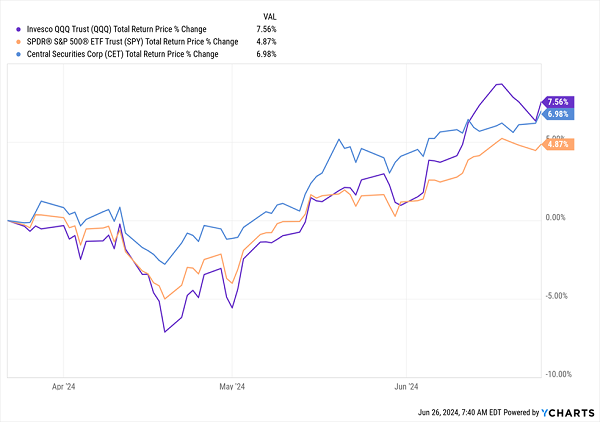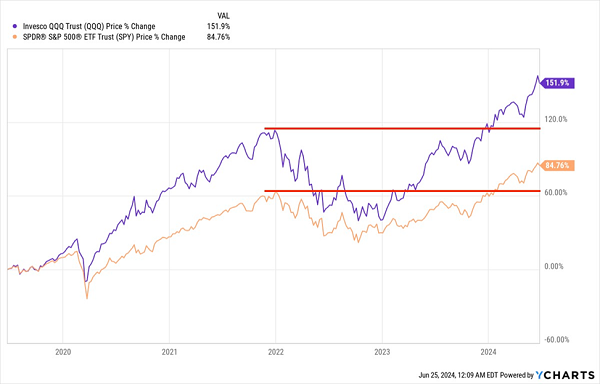As a contrarian dividend investor, I’ve always looked to buy when media-driven worries run directly counter to the data.
And these days, the media is more negative than it’s ever been, despite the data showing the economy is performing well. Today we’re going to exploit that divide and look at an overly discounted, 6.9% dividend that’s nicely positioned to profit from it.
Media and Experts Distort Their Real Views All the Time
What I’m really talking about here is the so-called “vibecession,” we discussed a few months ago—the feeling that we’re in a recession even though the data says the economy is performing well.
A “vibecession” is actually a great time to buy. For example, at my CEF Insider service, we added a closed-end fund (CEF) called the Central Securities Corporation (CET) to our portfolio in March, when it was yielding 8.2%.
Since then, it’s returned a nice 7% for us, topping the S&P 500 and just a hair off the NASDAQ’s strong run, even though CET holds stocks beyond tech, with American Express (AXP), Charles Schwab (SCHW) and insurer Progressive Corp. (PGR) showing up in its top-10 holdings.
Negative “Vibes” Gave Us a Buying Opportunity On CET

And the real gift with CET is that we’ll get most of our return in dividend cash, thanks to their high yields, which they generate in part by timely buys and sells in their portfolios. In essence, they’re “translating” stock gains into cash for us.
Media Negativity Is Higher Than It Was in the Great Depression
But back to the press for a moment. If you think the media is getting more negative these days, well, you’re right. This bias has actually been tracked over 170 years of American newspapers in a brilliant study from the National Bureau of Economic Research.
Better World, Uglier View

The higher the line on these charts, the higher the optimism about the economy in the news (the blue line) and about the world in general (the red line).
Notice how both lines are much lower than they were in the 19th century? Our sources have turned much more negative than they were at a time when most Americans worked 12-hour workdays, six days a week. The lowest economic sentiment of the Great Depression is higher than the peak optimism of the last 15 years!
The decline in optimism says a lot about human nature, but it says more about what the media’s job is. Remember that the media exists to warn us of potential problems, and thus the more the media identifies potential problems, the better it’s serving its function. The writers of this study point to this, as well:
“Because the public needs to be aware of important risks in society, a certain level of general negative bias in news coverage is expected, particularly if one adheres to the view that traditional media fulfills a watchdog/surveillance function.
Although this argument could explain the average level of negativity in news reporting, it does not address its increasingly downward trend. What factors could speak to it? The world of news, especially that of printed newspapers, has become increasingly competitive over the years. Therefore, It is natural to expect that to attract a larger audience, many outlets have been increasingly focusing on negative news.”
There is a two-step approach we contrarian dividend investors should take with regard to this trend.
First, we should ignore times of apocalyptic warnings. In the last decade we’ve been told that conflicts in the Middle East, in eastern Europe, in East Asia and elsewhere would cause the end of the world. But we’re still here. Acting on these warnings is essentially investing based on the headlines, and it’s never been riskier to your financial health than it is now.
The media is doing its job being more and more hysterical. As investors, we need to do our job and respond when things go too far.
In 2022 that meant buying stocks and CEFs, as we did during that panic-filled year at CEF Insider. Today, though, when the market seems overly euphoric, what do we do?
Still in Negativity’s Glow

The distortion of 2022 is something we’re still going through, and the market remains oversold. The S&P 500 is up 6.6% annualized from its prior peak in 2021, as of this writing, and the benchmark NASDAQ index fund, the Invesco QQQ Trust (QQQ) is up 8.3% annualized.
Both are still well below their longer-term trends: Over the last 15 years, QQQ has had a 19.9% annualized return, and the S&P 500 has returned 14.7% annualized. We are well below that, which means it’s still a great time to buy stocks—and more specifically stock-focused CEFs.
QQQX: NASDAQ Stocks With a 6.9% Dividend
For tech investing, do yourself a favor and go with a CEF called the Nuveen NASDAQ 100 Dynamic Overwrite Fund (QQQX) instead of the QQQ ETF I just mentioned.
Like QQQ, it holds all the stocks in the NASDAQ 100 index—including Microsoft (MSFT), Apple (AAPL) and NVIDIA (NVDA)—but instead of QQQ’s microscopic 0.6% yield, we get an outsized 6.9%.
The fund drives that dividend by selling call options (or the right to buy its stocks at a certain level on a certain date) on its portfolio, a canny move that generates an extra income stream (because it keeps the fees it charges for these options). That approach also helps reduce volatility.
As with CET, there’s a compelling discount angle here, too, with QQQX trading 11% below NAV, far beneath its five-year average of just 0.6%.
4 More “Vibecession” Buys to Pick Up Now
QQQX is okay to buy right now, but its option strategy does have the downside of capping its potential gains, as its best picks are called away.
That’s not the case with 4 other “pure” stock and bond CEFs I’m urging investors to buy now. They’re yielding a rich 9.3% as I write this and trade at deep discounts (I’m forecasting 20% price gains, on average, in the next 12 months from them).
Even with the negative media bias, I expect these 4 funds to soar as interest rates move lower and income investors go hunting for high-yield alternatives. Heck, a positive CPI report on July 11 could be enough to get these gains started.
We want to be in well before then. Click here and I’ll tell you more about how we ride closing CEF discounts to strong gains. I’ll also give you a free Special Report naming all four of these 9.3%-paying funds.

Recent Comments